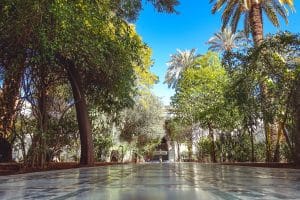A Bahia (The Beautiful) is an 8000-square-metre extravaganza of elaborate marquetry, plasterwork, and zouak (painted wood), and is undoubtedly one of Marrakesh’s most eye-catching attractions.
The Petit Riad and Large Riad salons include elaborate marquetry and zouak ceilings, but the Cour d’Honneur, a grand courtyard with a 1500 sq metre floor of Italian Carrara marble, is the undeniable showpiece.
Despite the large amount of space on display, just a section of the palace’s eight hectares and 150 rooms are available to the public. Its large halls occasionally hold significant cultural events.
History
Grand Vizier Si Moussa built the palace in the 1860s, and his son and successor Abu ‘Bou’ Ahmed extended and enhanced it from 1894 to 1900. The Court of Appeal
The salons of both the Petit Riad and Grand Riad host intricate marquetry and zouak ceilings, but the Cour d’Honneur, a grand courtyard, with its 1500 sq metre floor of Italian Carrara marble, is the undisputed highlight.
Despite the vast area on show, only a portion of the palace’s eight hectares and 150 rooms is open to the public. Its grand spaces sometimes play host to important cultural events.
History
Built by Grand Vizier Si Moussa in the 1860s, the palace was later expanded and embellished from 1894 to 1900 by his son and successor Abu ‘Bou’ Ahmed. The Cour d’Honneur (courtyard) was converted into a harem by Bou Ahmed after he became Grand Vizier in 1894. Indeed, the expansion and beautification of Bahia Palace was driven by Bou Ahmed’s desire to accommodate his four wives and 24 concubines.
Bou Ahmed died in 1900, and in 1908 the palace’s beguiling charms attracted warlord Pasha Glaoui, who claimed it as a suitable venue to entertain French guests. They, in turn, were so impressed that they booted out their host in 1912, installing the protectorate’s resident-general in his place.
When Morocco gained independence from France in 1956, the palace was used as a royal residence, until King Hassan II transferred it to the custody of the Moroccan Ministry of Culture, so the building could serve as a cultural icon and tourist attraction.



